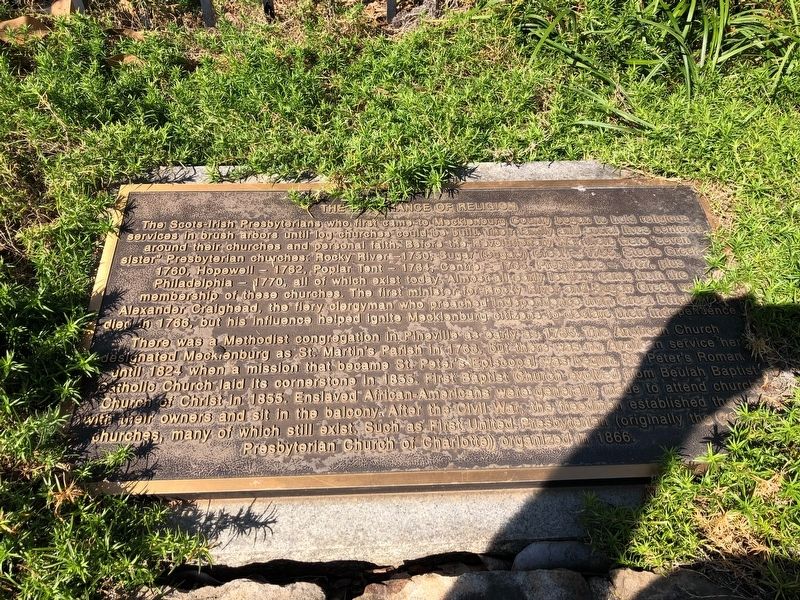Charlotte center city in Mecklenburg County, North Carolina — The American South (South Atlantic)
The Importance Of Religion
The Scots-Irish Presbyterians who first came to Mecklenburg County began to hold religious services in brush arbors until log churches could be built. Their family and social lives centered around their churches and personal faith. Before the Revolutionary War there were "even sister" Presbyterian churches: Rocky River - 1750, Sugar (Sugaw) Creek - 1755, Steele Creek - 1760, Hopewell - 1762, Poplar Tent - 1764, Centre - 1765, Providence - 1767, plus Philadelphia - 1770, all of which exist today. Almost all early leaders came from the membership of these churches. The first minister for Rocky River and Sugaw Creek was Alexander Craighead, the fiery clergyman who preached independence from Great Britain died in 1766, but his influence helped ignite Mecklenburg citizens to declare their independence.
There was a Methodist congregation in Pineville as early as 1785. The Anglican Church designated Mecklenburg as St. Martin's Parish in 1768, but there was no Anglican service here until 1824 when a mission that became St. Peter's Episcopal was begun. St. Peter's Roman Catholic Church laid its cornerstone in 1855. First Baptist Church evolved from Beulah Baptist Church of Christ in 1855. Enslaved African-Americans were generally made to attend church with their owners and sit in the balcony. After the Civil War, the freedmen established
their own churchest, many of which still exist. Such as First United Presbyterian (originally the Colored Presbyterian Church of Charlotte) organized in 1866.Topics. This historical marker is listed in these topic lists: African Americans • Churches & Religion • Colonial Era. A significant historical year for this entry is 1750.
Location. 35° 13.753′ N, 80° 50.594′ W. Marker is in Charlotte, North Carolina, in Mecklenburg County. It is in Charlotte center city. Marker is on West 5th Street just west of North Church Street, on the right when traveling west. Touch for map. Marker is at or near this postal address: 200 W Trade St, Charlotte NC 28202, United States of America. Touch for directions.
Other nearby markers. At least 8 other markers are within walking distance of this marker. Hornets' Nest (here, next to this marker); Early Education (here, next to this marker); The Battle of Charlotte (here, next to this marker); Gold Mining (here, next to this marker); Captain James Jack's Ride (here, next to this marker); The Mecklenburg Declaration of Independence (here, next to this marker); Census Information (here, next to this marker); The War Between The States (here, next to this marker). Touch for a list and map of all markers in Charlotte.
Credits. This page was last revised on February 3, 2023. It was originally submitted on June 20, 2021, by Devry Becker Jones of Washington, District of Columbia. This page has been viewed 180 times since then and 22 times this year. Photos: 1, 2. submitted on June 20, 2021, by Devry Becker Jones of Washington, District of Columbia.

